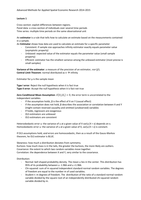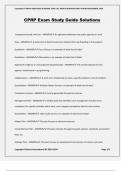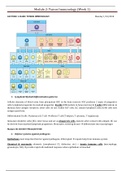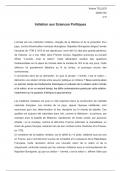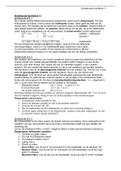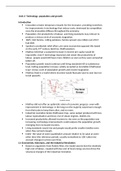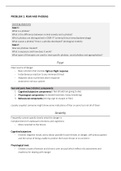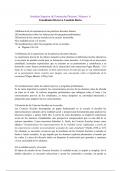Advanced Methods for Applied Spatial Economic Research 2014-2015
Lecture 1
Cross-section: exploit differences between regions.
Panel data: a cross-section of individuals over several time-periods
Time series: multiple time periods on the same observational unit
An estimator is a rule that tells how to calculate an estimate based on the measurements contained
in a sample.
An Estimator shows how data are used to calculate an estimate for a specific parameter
- Consistent: if sample size approaches infinity estimator exactly equals parameter value
(asymptotic property)
- Unbiased: expected value of the estimator equals the parameter value (small sample
property)
- Efficient: estimator has the smallest variance among the unbiased estimator (most precise is
small samples)
Variance of the estimator: a measure of the precision of an estimator, 𝑣𝑎𝑟(𝑝̂ ).
Central Limit Theorem: normal distributed as n infinity
Estimator for μ is the sample mean
Type I error: Reject the null hypothesis when it is fact true
Type II error: Accept the null hypothesis when it is fact not true
Zero Conditional Mean Assumption: 𝐸 [𝑈𝑖 |𝑋𝑖 ] = 0, the error term is uncorrelated to the
independant variables.
- If the assumption holds, β is the effect of X on Y (causal effect)
- If the assumption does not hold, β describes the association or correlation between X and Y
(might contain reversed causality and omitted (unobserved) variables
- If holds, regressors are exogenous
- OLS estimators are unbiased
- OLS estimators are consistent
Heteroskedastic error u: the variance of u at a given value of X var(u|X = x) depends on x.
Homoskedastic error u: the variance of u at a given value of X, var(u|X = x) is constant.
If OLS assumptions hold, and errors are homoscedastic, then as a result of the Gauss-Markov
theorem, he OLS estimator is BLUE.
Skewness: how much a distribution deviates from symmetry.
Kurtosis: how much mass is in the tails, the greater the kurtosis, the more likely are outliers.
Covariance: the extent to which two random variables move together.
Correlation: the dependence between X and Y, very similar to the covariance.
Distribution:
- Normal: bell shaped probability density. The mean u lies in the center. This distribution has
95% of its probability between u -1.966 and u +1.966.
- Chi-squared: sum of m squared independent standard normal random variables. The degrees
of freedom are equal to the number m of used variables.
- Student t: m degrees of freedom. The distribution of the ratio of a standard normal random
variable divided by the square root of an independently distributed chi-squared random
variable divided by m.
Lecture 1
Cross-section: exploit differences between regions.
Panel data: a cross-section of individuals over several time-periods
Time series: multiple time periods on the same observational unit
An estimator is a rule that tells how to calculate an estimate based on the measurements contained
in a sample.
An Estimator shows how data are used to calculate an estimate for a specific parameter
- Consistent: if sample size approaches infinity estimator exactly equals parameter value
(asymptotic property)
- Unbiased: expected value of the estimator equals the parameter value (small sample
property)
- Efficient: estimator has the smallest variance among the unbiased estimator (most precise is
small samples)
Variance of the estimator: a measure of the precision of an estimator, 𝑣𝑎𝑟(𝑝̂ ).
Central Limit Theorem: normal distributed as n infinity
Estimator for μ is the sample mean
Type I error: Reject the null hypothesis when it is fact true
Type II error: Accept the null hypothesis when it is fact not true
Zero Conditional Mean Assumption: 𝐸 [𝑈𝑖 |𝑋𝑖 ] = 0, the error term is uncorrelated to the
independant variables.
- If the assumption holds, β is the effect of X on Y (causal effect)
- If the assumption does not hold, β describes the association or correlation between X and Y
(might contain reversed causality and omitted (unobserved) variables
- If holds, regressors are exogenous
- OLS estimators are unbiased
- OLS estimators are consistent
Heteroskedastic error u: the variance of u at a given value of X var(u|X = x) depends on x.
Homoskedastic error u: the variance of u at a given value of X, var(u|X = x) is constant.
If OLS assumptions hold, and errors are homoscedastic, then as a result of the Gauss-Markov
theorem, he OLS estimator is BLUE.
Skewness: how much a distribution deviates from symmetry.
Kurtosis: how much mass is in the tails, the greater the kurtosis, the more likely are outliers.
Covariance: the extent to which two random variables move together.
Correlation: the dependence between X and Y, very similar to the covariance.
Distribution:
- Normal: bell shaped probability density. The mean u lies in the center. This distribution has
95% of its probability between u -1.966 and u +1.966.
- Chi-squared: sum of m squared independent standard normal random variables. The degrees
of freedom are equal to the number m of used variables.
- Student t: m degrees of freedom. The distribution of the ratio of a standard normal random
variable divided by the square root of an independently distributed chi-squared random
variable divided by m.

